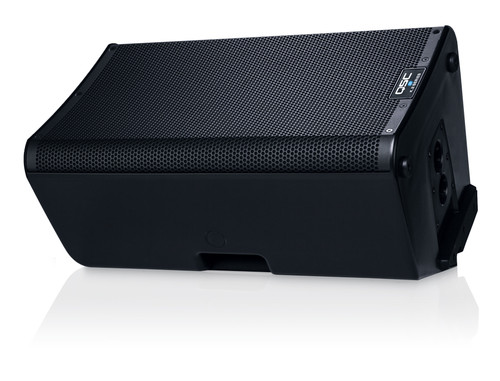Overview
PowerLight 3 Series is comprised of our “Ultimate Analog” power house amplifier, designed for the most demanding concert and live-sound reinforcement applications. The PL380 features the ground breaking PowerLight™ power supply technology, dramatically reducing weight, eliminating AC mains hum and improving audio quality. Comprehensive remote control and monitoring can also be achieved via the Q-SYS networked platform.
Features
- PowerLight switch-mode power supply for highest efficiency and improved audio performance
- Flow-through air path and solid aluminum heat sinks for maximum cooling
- DataPort supports remote network control and monitoring via Q-SYS
- Detented gain controls with 1-dB steps for precise calibration
- Removable knobs with lock-out security plate to prevent unauthorized tampering
- User defeatable clip limiters and selectable low-frequency filter per channel (3 Hz, 30 Hz, or 50 Hz)
- Three selectable gain structures (26 dB, 32 dB, or 1.2 V)
- Front and rear panel LEDs indicate status of switch settings at a glance
- Parallel XLR/M and XLR/F connectors for simple loop-through connectivity
- Neutrik Speakon® and "Touch-Proof" binding post outputs
- Neutrik Powercon® power cable remains secure on the road
- 3 year warranty, plus optional 3 year extended service contract
- Linear Class H output circuit offer double the typical efficiency of Class B, reducing AC current consumption and cooling requirements
-
Class D output circuit produces massive output power with even lower losses and minimal increase in average AC power, dramatically reducing power distribution demands compared to older high power amplifiers
| SPECIFICATIONS | PL380 |
| OUTPUT POWER PER CHANNEL, STERO MODE, both channels driven | |
| 8Ω EIA 1 kHz 1% THD | 1500 W |
| 4Ω EIA 1 kHz 1% THD | 2500 W |
| 2Ω EIA 1 kHz 1% THD | 4000 W* |
| OUTPUT POWER, BRIDGE MONO MODE | |
| 8Ω EIA 1 kHz 1% THD | 5000 W |
| 4Ω EIA 1 kHz 1% THD | 8000 W* |
| Typical Distortion (20 Hz–3 kHz, 3 dB below clip, or 20 Hz–5 kHz, 10 dB below clip, or 20 Hz–20 kHz, 20 dB below clip) 8 ohms 4 ohms 2 ohms | 0.01-0.03% 0.03-0.06% 0.1% |
| Maximum Distortion (20 Hz–20 kHz, 1 dB below rated power) 4 to 8 ohms | 0.2% |
| Frequency Response (8 ohms) | 20 Hz–20 kHz, ±0.2 dB |
| Noise (20 Hz–20 kHz, 32 dB Gain) | -104 dB |
| Dynamic Headroom (4 ohms) | 2 dB |
| Damping Factor (8 ohms) | 200 |
| Output Circuitry | Class D |
| Input Sensitivity 26 dB Setting 32 dB Setting | 5.27V 2.67V |
| Maximum Gain (1.2V setting) | 39.1 dB |
| Maximum Input Level 1.2V setting 32 dBu setting 26 dBu setting | 10 V (+22 dBu) 22 V (+29 dBu) 25 V (+30 dBu) |
| AC Power Requirements ** 120V 50/60 Hz 230V 50 Hz | 18 A 11 A |
| Cordset 120V 50/60 Hz 230V 50 Hz | NEMA L5-30P CEE 7/7 16A |
| Chassis Power Connector All Voltages | 32A PowerCon |
| Input Impedance | > 10 kΩ balanced, or unbalanced |
| Cooling | Variable-speed fan, rear-to-front air flow |
| Connectors (each channel) | Input: XLR Male, XLR Female and 3-pin detachable terminal blocks (1 each per channel) Output: Neutrik Speakon® (ch 1 wired to both channels) and 5-way binding posts DataPort: HD-15, input signal in parallel with XLR input connectors |
| Front Controls | AC power switch Gain controls, 21 detents, 1 dB steps (each channel) |
| Front Indicators (LED color) | Power (Blue) Bridged (Yellow) Parallel (Orange) Clip/Prot (Red × 2) Level -10 (Orange × 2) Level -20 (Green × 2) Signal -35 (Green × 2) |
| Rear Controls (with LED indicators) | Input Mode: Bridge (Yellow), Stereo (Green), or Parallel (Orange) Gain / Sensitivity: 26 dB (Orange), 32 dB (Green), or 1.2V (Yellow) High Pass (each channel): 3 Hz (Off), 30 Hz (Yellow), or 50 Hz (Orange) Clip Limiter (each channel): Off, on (Yellow) |
| Amplifier and Load Protection | Short circuit, open circuit, thermal, RF protection. On/off muting, DC fault shutdown, active inrush limiting |
| Dimensions | Height: 3.5" (8.9 cm) 2RU Width: 19" (48.3 cm) Depth: 15.63" (39.7 cm) from front mounting rails |
| Weight | Net: 24 lb (11 kg) Shipping: 33.5 lb (15.2 kg) |
| Agency Approvals | UL, CE, RoHS/WEEE compliant, FCC Class B (conducted and radiated emissions) |






